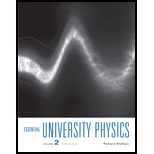
Essential University Physics: Volume 2 (3rd Edition)
3rd Edition
ISBN: 9780321976420
Author: Richard Wolfson
Publisher: PEARSON
expand_more
expand_more
format_list_bulleted
Concept explainers
Question
Chapter 39, Problem 11FTD
To determine
The forces that unified in GUT.
Expert Solution & Answer
Want to see the full answer?
Check out a sample textbook solution
Students have asked these similar questions
Hi! I need help with these calculations for part i and part k for a physics Diffraction Lab. We used a slit width 0.4 mm to measure our pattern.
Examine the data and % error values in Data Table 3 where the angular displacement of the simple pendulum decreased but the mass of the pendulum bob and the length of the pendulum remained constant. Describe whether or not your data shows that the period of the pendulum depends on the angular displacement of the pendulum bob, to within a reasonable percent error.
In addition to the anyalysis of the graph, show mathematically that the slope of that line is 2π/√g . Using the slope of your line calculate the value of g and compare it to 9.8.
Chapter 39 Solutions
Essential University Physics: Volume 2 (3rd Edition)
Ch. 39 - Prob. 1FTDCh. 39 - Prob. 2FTDCh. 39 - Prob. 3FTDCh. 39 - Prob. 4FTDCh. 39 - Prob. 5FTDCh. 39 - Prob. 6FTDCh. 39 - Prob. 7FTDCh. 39 - Prob. 8FTDCh. 39 - Name the fundamental force involved in (a) binding...Ch. 39 - Prob. 10FTD
Ch. 39 - Prob. 11FTDCh. 39 - Prob. 12FTDCh. 39 - Prob. 13FTDCh. 39 - Prob. 14FTDCh. 39 - Describe the origin of the cosmic microwave...Ch. 39 - Prob. 16FTDCh. 39 - Prob. 17FTDCh. 39 - The radiation that we observe as the cosmic...Ch. 39 - Prob. 19FTDCh. 39 - Prob. 20FTDCh. 39 - Prob. 21ECh. 39 - Prob. 22ECh. 39 - Prob. 23ECh. 39 - Prob. 24ECh. 39 - Prob. 25ECh. 39 - Prob. 26ECh. 39 - Prob. 27ECh. 39 - Prob. 28ECh. 39 - Prob. 29ECh. 39 - Prob. 30ECh. 39 - Prob. 31ECh. 39 - Prob. 32ECh. 39 - Prob. 33ECh. 39 - Prob. 34ECh. 39 - Prob. 35ECh. 39 - Prob. 36ECh. 39 - Prob. 37ECh. 39 - Prob. 38PCh. 39 - Prob. 39PCh. 39 - Prob. 40PCh. 39 - Prob. 41PCh. 39 - Prob. 42PCh. 39 - Prob. 43PCh. 39 - Prob. 44PCh. 39 - Prob. 45PCh. 39 - Prob. 46PCh. 39 - Prob. 47PCh. 39 - Prob. 48PCh. 39 - Prob. 49PCh. 39 - Prob. 50PCh. 39 - Prob. 51PCh. 39 - Prob. 52PCh. 39 - Prob. 53PCh. 39 - Prob. 54PCh. 39 - Prob. 55PCh. 39 - Prob. 56PCh. 39 - Prob. 57PCh. 39 - Prob. 58PCh. 39 - Prob. 59PCh. 39 - Prob. 60PCh. 39 - Prob. 61PPCh. 39 - Prob. 62PPCh. 39 - Prob. 63PPCh. 39 - Prob. 64PP
Knowledge Booster
Learn more about
Need a deep-dive on the concept behind this application? Look no further. Learn more about this topic, physics and related others by exploring similar questions and additional content below.Similar questions
- An object is placed 24.1 cm to the left of a diverging lens (f = -6.51 cm). A concave mirror (f= 14.8 cm) is placed 30.2 cm to the right of the lens to form an image of the first image formed by the lens. Find the final image distance, measured relative to the mirror. (b) Is the final image real or virtual? (c) Is the final image upright or inverted with respect to the original object?arrow_forwardConcept Simulation 26.4 provides the option of exploring the ray diagram that applies to this problem. The distance between an object and its image formed by a diverging lens is 5.90 cm. The focal length of the lens is -2.60 cm. Find (a) the image distance and (b) the object distance.arrow_forwardPls help ASAParrow_forward
arrow_back_ios
SEE MORE QUESTIONS
arrow_forward_ios
Recommended textbooks for you
 AstronomyPhysicsISBN:9781938168284Author:Andrew Fraknoi; David Morrison; Sidney C. WolffPublisher:OpenStax
AstronomyPhysicsISBN:9781938168284Author:Andrew Fraknoi; David Morrison; Sidney C. WolffPublisher:OpenStax Modern PhysicsPhysicsISBN:9781111794378Author:Raymond A. Serway, Clement J. Moses, Curt A. MoyerPublisher:Cengage Learning
Modern PhysicsPhysicsISBN:9781111794378Author:Raymond A. Serway, Clement J. Moses, Curt A. MoyerPublisher:Cengage Learning College PhysicsPhysicsISBN:9781305952300Author:Raymond A. Serway, Chris VuillePublisher:Cengage Learning
College PhysicsPhysicsISBN:9781305952300Author:Raymond A. Serway, Chris VuillePublisher:Cengage Learning Physics for Scientists and Engineers: Foundations...PhysicsISBN:9781133939146Author:Katz, Debora M.Publisher:Cengage Learning
Physics for Scientists and Engineers: Foundations...PhysicsISBN:9781133939146Author:Katz, Debora M.Publisher:Cengage Learning Principles of Physics: A Calculus-Based TextPhysicsISBN:9781133104261Author:Raymond A. Serway, John W. JewettPublisher:Cengage Learning
Principles of Physics: A Calculus-Based TextPhysicsISBN:9781133104261Author:Raymond A. Serway, John W. JewettPublisher:Cengage Learning Physics for Scientists and Engineers with Modern ...PhysicsISBN:9781337553292Author:Raymond A. Serway, John W. JewettPublisher:Cengage Learning
Physics for Scientists and Engineers with Modern ...PhysicsISBN:9781337553292Author:Raymond A. Serway, John W. JewettPublisher:Cengage Learning

Astronomy
Physics
ISBN:9781938168284
Author:Andrew Fraknoi; David Morrison; Sidney C. Wolff
Publisher:OpenStax

Modern Physics
Physics
ISBN:9781111794378
Author:Raymond A. Serway, Clement J. Moses, Curt A. Moyer
Publisher:Cengage Learning

College Physics
Physics
ISBN:9781305952300
Author:Raymond A. Serway, Chris Vuille
Publisher:Cengage Learning

Physics for Scientists and Engineers: Foundations...
Physics
ISBN:9781133939146
Author:Katz, Debora M.
Publisher:Cengage Learning

Principles of Physics: A Calculus-Based Text
Physics
ISBN:9781133104261
Author:Raymond A. Serway, John W. Jewett
Publisher:Cengage Learning

Physics for Scientists and Engineers with Modern ...
Physics
ISBN:9781337553292
Author:Raymond A. Serway, John W. Jewett
Publisher:Cengage Learning